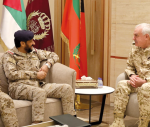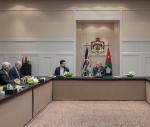You are here
Will nuclear history repeat itself in Korea?
Apr 05,2017 - Last updated at Apr 05,2017
As Chinese President Xi Jinping’s first summit with US President Donald Trump takes place at Trump’s luxurious Florida estate Mar-a-Lago, at least part of the discussion will invariably focus on one of the world’s most impoverished places: North Korea.
Despite more than two decades of on-again, off-again negotiations, North Korea’s nuclear weapons programme is pushing the world towards a strategic watershed much like the one that the West faced 60 years ago, when the United States and the Soviet Union faced off against each other in Europe.
The US and its allies successfully navigated the challenge of Europe in the twentieth century without war. But to achieve comparable success in East Asia today, Trump must persuade Xi to adopt a different policy towards North Korea.
When the US and the Soviet Union became rivals after World War II, each had a way of deterring the other from attacking.
The Soviet Union had — or was widely believed to have — a large advantage in non-nuclear forces, which the Kremlin could use to conquer Western Europe.
The US, with its monopoly on nuclear weapons, could launch a nuclear strike from Europe on the Soviet homeland.
Then, in 1957, the launch of Sputnik made it clear that the Soviet Union would soon be able to deliver a nuclear strike on the US mainland, calling into question the effectiveness of American deterrence.
Was it credible that, in response to an attack on Western Europe, the US would make war on the Soviet Union, thus inviting a nuclear attack on its own territory?
America and its allies had four possible solutions to this novel and dangerous problem: preemption, defence, proliferation and deterrence.
Preemption — an attack on the Soviet Union’s nuclear weapons — would have started World War III, a distinctly unappealing prospect.
And as the Soviet nuclear arsenal grew, the US government ruled out defence against a missile attack: because it could not deflect every incoming nuclear explosive, it would be safer if neither side tried to build ballistic missile defences.
President Richard Nixon’s administration therefore negotiated and signed the 1972 Soviet-American Anti-Ballistic Missile (ABM) Treaty, effectively banning such systems.
The third option, acquisition of nuclear armaments by potentially threatened countries, was based on the assumption that a government would be willing to use such weapons to defend its own country, if not another one.
French President Charles de Gaulle invoked this logic to justify his country’s nuclear weapons programme, although he also had other reasons for wanting France to join the nuclear “club”.
By this logic, however, West Germany, too, needed a nuclear arsenal; and, given Germany’s twentieth-century history, no one, least of all the Germans, desired such an outcome.
So the West opted to reinforce the status quo, with the US seeking to enhance the credibility of its policy of deterrence in Europe by stating, publicly and frequently, that it would indeed defend its allies, despite the risk that this would lead to an attack on its own territory.
The US backed up its stance by deploying nuclear weapons on the European continent, and by stationing troops on the front lines in Germany as a “trip-wire”: an attack there would trigger US participation in any war the communist side might begin.
This strategy worked: for whatever combination of reasons, the Soviet Union never launched a westwards attack of any kind.
Six decades later, a similar challenge looms on the Korean Peninsula.
Since the end of the Korean War in 1953, a US military presence has helped deter a North Korean attack on the South, while the communist North has deterred the US as well: its massive artillery deployments along the demilitarised zone dividing the peninsula could devastate South Korea’s capital, Seoul, with its ten million people, in retaliation for any US attack.
North Korea’s nuclear weapons programme threatens to upset that balance, by giving its regime the capacity, through the long-range ballistic missiles it is testing, to strike the West Coast of the US, thereby raising a new version of an old question: would the US risk Los Angeles to protect Seoul?
The US and its Asian allies have the same four options as the Atlantic Alliance had 60 years ago.
They can attempt to live with North Korean long-range nuclear missiles, relying on deterrence. Peace, and the safety of millions of Americans, would then depend on the prudence and rationality of North Korea’s 33-year-old dictator, Kim Jong-un, a young man with a taste for grotesque executions of family members and close associates.
In the past, such an outcome has seemed unacceptable to US national security experts.
In June 2006, William Perry, a former defence secretary, and Ashton Carter, a future one, argued in The Washington Post that if North Korea deployed on its territory a nuclear-armed missile capable of hitting the US, the US should attack and destroy it.
But, like the status quo, attacking the North’s nuclear arsenal would carry enormous risks.
Such an attack would likely trigger a second Korean War. The North would surely lose, and the regime would collapse, but probably not until it inflicted terrible damage on South Korea, and perhaps also on Japan.
Having withdrawn from the ABM Treaty, the US has already begun to deploy missile-defence systems, with the hope of defeating a small-scale nuclear assault (though not a massive attack of the kind Russia could launch).
This option, too, carries grave risks. As the North Korean nuclear arsenal grows, the effectiveness of missile defence will diminish. Even one nuclear explosion in the US, South Korea or Japan would be a catastrophe.
If East Asian countries come to doubt the credibility of the US commitment to their defence — and Trump has made clear his reservations about US alliances — they can build their own nuclear weapons, as France did.
Japan, South Korea and Taiwan are certainly capable of doing so rapidly.
But an East Asia in which several countries possessed nuclear weapons would not necessarily be stable.
Unlike Europe during the Cold War, it would have several nuclear powers, not just two; and some of them would lack the capacity for “assured destruction” — that is, the ability to absorb a nuclear strike and still inflict devastating damage on the attacker.
Without such a capacity, a nuclear-armed country has a much greater incentive than the US and the Soviet Union did to launch a first strike if it suspects that it will be attacked.
Deterrence, preemption, defence and proliferation: none of the four possible responses to the progress of the North Korean nuclear programme inspires confidence.
But an important difference between twenty-first-century East Asia and twentieth-century Europe creates a chance to avoid all four: China is in a position to exert powerful pressure on the source of the nuclear threat.
Almost all North Korea’s food and fuel comes from neighbouring China. But despite its opposition to North Korea’s nuclear weapons programme and its lack of enthusiasm for the Kim dynasty, the Chinese government has thus far refrained from applying pressure by threatening to sever the North’s lifeline.
China’s bigger fear is the collapse of the Kim regime, which would send a wave of unwanted refugees across its border and could create a new and unwanted neighbour: a reunified Korean state allied with the US.
While the Chinese may have good reasons to prefer the status quo on the Korean Peninsula, continuing to indulge the North Korean leadership’s nuclear ambitions is a risky option.
China could find itself surrounded by unfriendly nuclear-armed states, or with a nasty war on its border, or perhaps both.
Trump should emphasise that point to Xi.
At the very least, North Korea’s nuclear progress, unless China acts to stop it, will make East Asia a far more dangerous place for everyone, including the Chinese themselves.
Mark Twain observed that everybody talks about the weather, but nobody does anything about it.
That has been true of North Korea’s nuclear weapons programme for almost a quarter-century. It may not be true for much longer.
The writer is professor emeritus of American Foreign Policy at The Johns Hopkins School of Advanced International Studies and author, most recently, of “Mission Failure: America and the World in the Post-Cold War Era”. ©Project Syndicate, 2017. www.project-syndicate.org











